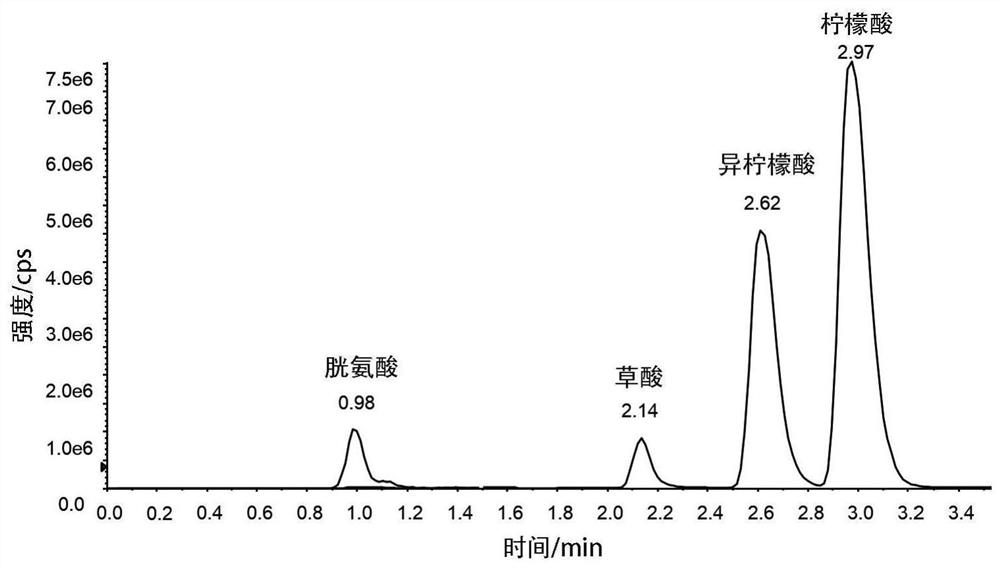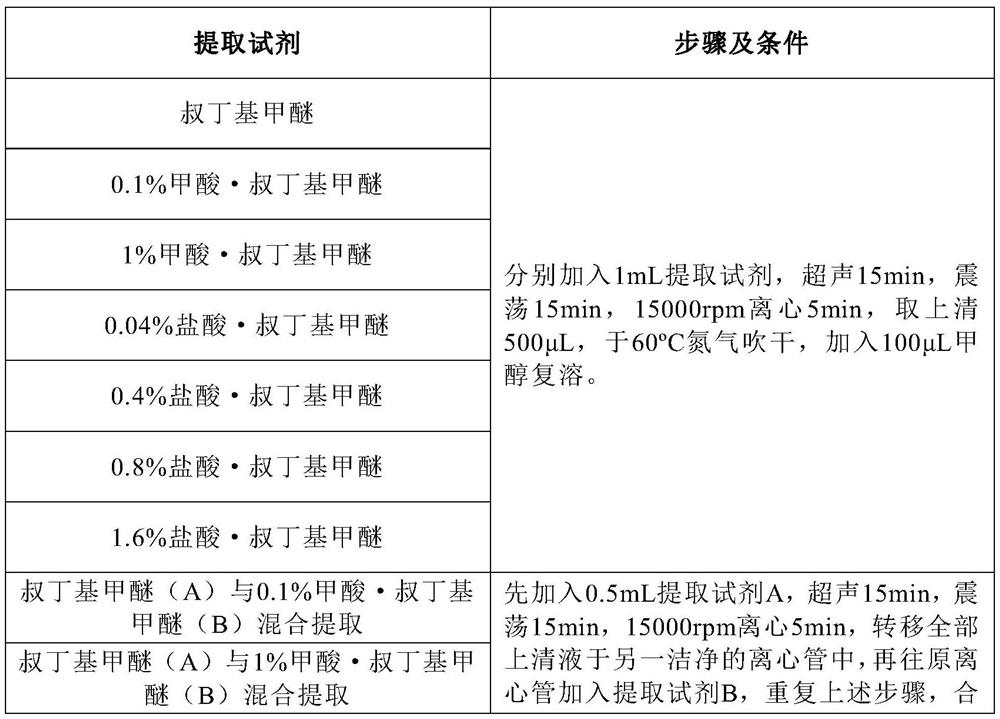A kit and method for simultaneously extracting organic acids and amino acids
A technology of organic acids and amino acids, applied in the field of chemical analysis, can solve the problems of unprepared diagnosis of urinary calculi and the inability to provide organic acids and amino acids at the same time, and achieve the effect of improving detection efficiency
- Summary
- Abstract
- Description
- Claims
- Application Information
AI Technical Summary
Problems solved by technology
Method used
Image
Examples
Embodiment 1
[0069] Embodiment 1 tert-butyl methyl ether and acidification extraction
[0070] As an extraction reagent, tert-butyl methyl ether has a wide range of applicability and is very suitable for the extraction of polar substances. The targets (citric acid, oxalic acid and cystine) in the sample to be extracted are all highly polar substances, and the chemical structural formula of tert-butyl methyl ether is It is very similar to the target. According to the principle of similar compatibility, tert-butyl methyl ether is considered to be the preferred test; on the other hand, tert-butyl methyl ether is highly volatile, which can greatly save sample concentration time and cost.
[0071] The consideration for acid extraction is that cystine, oxalic acid and citric acid all contain carboxyl groups, which are strong electron withdrawing groups, which are easier to combine with protons in acidic tert-butyl methyl ether, and the target substance and protons in acidic tert-butyl methyl ethe...
Embodiment 2
[0095] Example 2 Other extraction reagents and alkalization extraction
[0096] In order to further screen the extraction reagents that can simultaneously extract the above-mentioned target products, the inventors selected other extraction reagents and tested them according to the above-mentioned failure reasons, and tried the alkalization extraction method at the same time.
[0097] The extraction reagents were ethyl acetate, n-hexane, 0.5% ammonia water·tert-butyl methyl ether, 0.5% ammonia water·ethyl acetate, and 0.5% ammonia water·n-hexane, and tert-butyl methyl ether was used as a control.
[0098] The derivatization steps are the same as those in Example 1.
[0099] After the samples were derivatized, they were dried under nitrogen, and 1 mL of extraction reagents (tert-butyl methyl ether, ethyl acetate, n-hexane, 0.5% ammonia water·tert-butyl methyl ether, 0.5% ammonia water·ethyl acetate, and 0.5% ammonia water·n-hexane) were added, respectively. Sonicate for 15 min,...
Embodiment 3
[0107] Embodiment 3 Optimization of ammonia water content of ammonia water·ethyl acetate extraction reagent
[0108] As can be seen from the results of Example 2, the simultaneous extraction of amino acids and organic acids can be achieved by using basic ethyl acetate as an extraction reagent, but the concentration of ammonia water will affect the extraction efficiency of each target to varying degrees. Therefore, the inventor further optimizes the concentration of ammonia water, In order to achieve the highest comprehensive extraction efficiency. The ammonia content is shown in Table 5:
[0109] Table 5 Optimization of ammonia water and ethyl acetate extraction reagent for ammonia water content
[0110]
[0111] Comprehensive comparison found that 0.2-0.6% ammonia water·ethyl acetate as extraction reagents could effectively extract cystine, oxalic acid and citric acid, and the relative extraction efficiency was higher than 20%. Among them, the relative extraction efficie...
PUM
 Login to View More
Login to View More Abstract
Description
Claims
Application Information
 Login to View More
Login to View More - R&D
- Intellectual Property
- Life Sciences
- Materials
- Tech Scout
- Unparalleled Data Quality
- Higher Quality Content
- 60% Fewer Hallucinations
Browse by: Latest US Patents, China's latest patents, Technical Efficacy Thesaurus, Application Domain, Technology Topic, Popular Technical Reports.
© 2025 PatSnap. All rights reserved.Legal|Privacy policy|Modern Slavery Act Transparency Statement|Sitemap|About US| Contact US: help@patsnap.com



